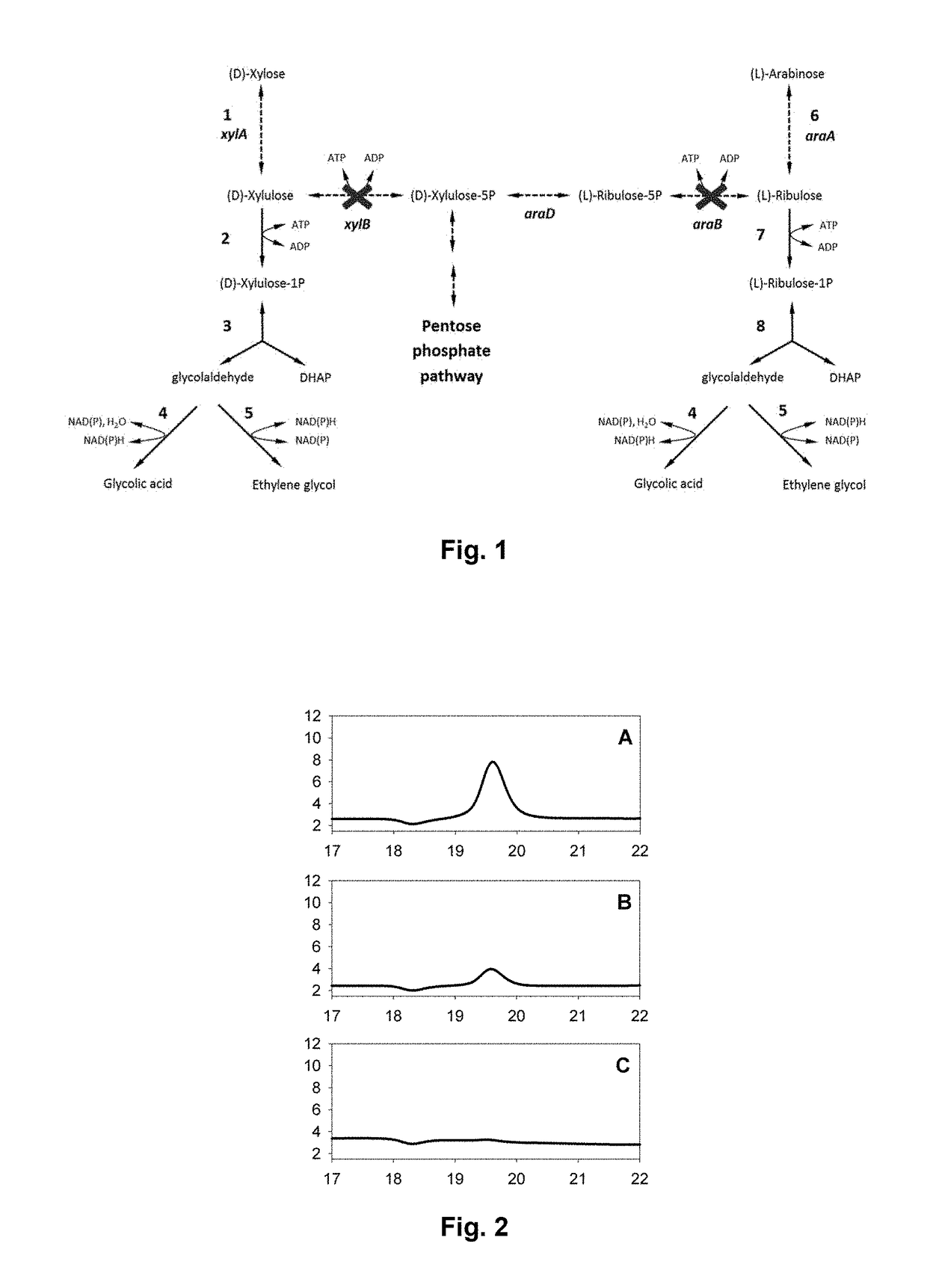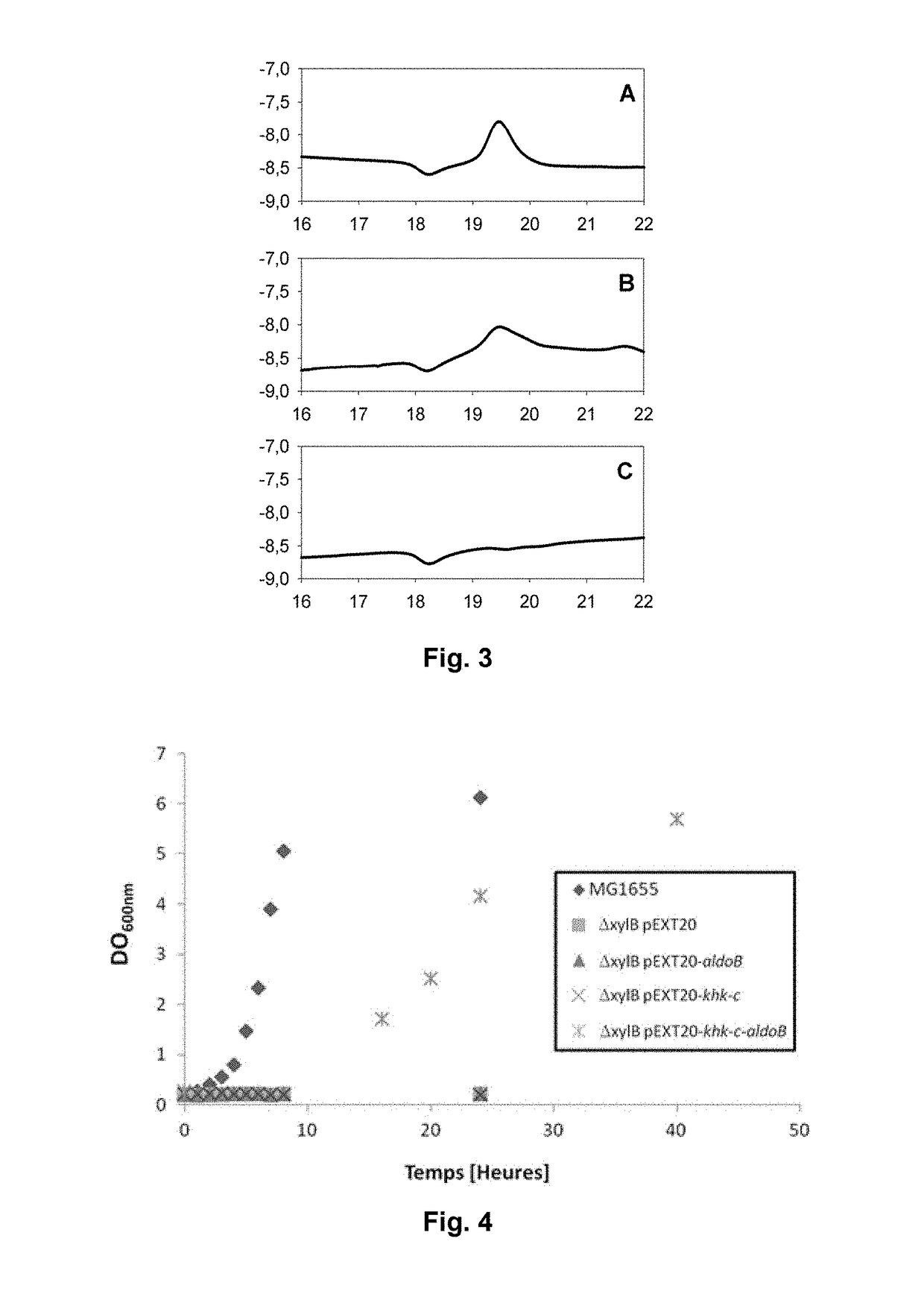Process for producing at least one metabolite of interest by conversion of a pentose in a microorganism
a technology of metabolites and microorganisms, applied in the direction of fertilization, etc., can solve the problem of extremely low yield and achieve the effect of simple and cost-efficien
- Summary
- Abstract
- Description
- Claims
- Application Information
AI Technical Summary
Benefits of technology
Problems solved by technology
Method used
Image
Examples
example 1
tion of the (D)-Xylulose-1-Kinase and (L)-Ribulose-1-Kinase Activities
[0341]Cloning of the Candidate Xylulokinases: khkC, rhaB and fucK in pET28a
[0342]The cloning of the khkC (SEQ ID No 1), rhaB (SEQ ID No 6) and fucK (SEQ ID No 5) genes in pET28a was carried out as indicated hereafter. The khk-C gene was digested from the pET11a-khk-C (Asipu et al., 2003) by NdeI / EcoRI. It was inserted by ligation thanks to the ligase T4 (Biolabs) following the tag-histidine of pET28a previously digested with the same enzymes. The rhaB and fucK cloning was carried out by amplifying rhaB and fucK by PCR from E. coli genomic DNA with the following primers, P1 / P2, P3 / P4, respectively, listed in table 3. The fragments were then cloned in the vector pGEM-T (Invitrogen). They were then digested by NcoI and BamHI and then ligated in the plasmid pET28a at the MCS previously digested with the same enzymes. The ligation product is transformed in an E. coli strain BL21(DE3). The vectors pET28-khk-C, pET28-rha...
example 2
tion of the (D)-Xylulose-1P-Aldolase and (L)-Ribulose-1P-Aldolase Activities
Cloning of the Genes Encoding the Candidate Aldolases AldoB, FbaB and AgaY
[0348]The cloning of the candidate aldolases was done by amplifying aldoB, fbaB and agaY by PCR (using, respectively, the primer pairs P5 / P6, P7 / P8 and P11 / P12 listed in table 3). This amplification was performed from the plasmid peX-A-aldoB carrying aldoB with codon optimization (Eurofins) or from the E. coli genomic DNA for fbaB and agaY, respectively. The fragments were then cloned in pGEM (Invitrogen). They were then digested by BamHI and HindIII (for aldoB) or NdeI and BamHI (for fbaB and agaY) and then ligated in the plasmid pET28a at MCS previously digested by BamHI and HindIII or NdeI and BamHI to clone aldoB (SEQ ID No 2) or fbaB (SEQ ID No 9) and agaY (SEQ ID No 8), respectively. The ligation product is transformed in the E. coli strain BL21(DE3). The vectors pET28-aldoB, pET28-fbaB, and pET28-agaY thus obtained were verified...
example 3
Functioning of the Synthetic Metabolic Pathway for Pentose Assimilation
In Vitro Functioning of the Synthetic Metabolic Pathway for (D)-Xylose Assimilation
[0352]The metabolic pathway for (D)-xylose assimilation has been reconstituted in vitro using purified enzymes (commercial and expressed and then purified from E. coli) from (D)-xylulose to demonstrate its functioning by producing ethylene glycol (FIG. 1).
[0353]The enzymes used for implementing the synthetic metabolic pathway were the following:[0354]Khk-C (Ketohexokinase / H. sapiens), encoded by the khkC gene of sequence SEQ ID NO:1 or KHK-A (Prospecbio);[0355]Aldolase B (AldoB / H. sapiens), encoded by the aldoB gene of sequence SEQ ID NO:2 or rabbit aldolase (Sigma-Aldrich-A2714);[0356]Glycerol dehydrogenase Cellulomonas sp. (Sigma-aldrich / G3512-250U).
[0357]The reaction medium comprised the Hepes buffer (90 mM Hepes; 77 mM KCl; 6.8 mM MgCl2) at pH=7; 4 mM ATP; 0.4 mM NADH; 0.005 Unit / ml Khk-A (Prospecbio) or Khk-C (purified from pE...
PUM
| Property | Measurement | Unit |
|---|---|---|
| temperature | aaaaa | aaaaa |
| temperature | aaaaa | aaaaa |
| pH | aaaaa | aaaaa |
Abstract
Description
Claims
Application Information
 Login to View More
Login to View More - R&D
- Intellectual Property
- Life Sciences
- Materials
- Tech Scout
- Unparalleled Data Quality
- Higher Quality Content
- 60% Fewer Hallucinations
Browse by: Latest US Patents, China's latest patents, Technical Efficacy Thesaurus, Application Domain, Technology Topic, Popular Technical Reports.
© 2025 PatSnap. All rights reserved.Legal|Privacy policy|Modern Slavery Act Transparency Statement|Sitemap|About US| Contact US: help@patsnap.com



